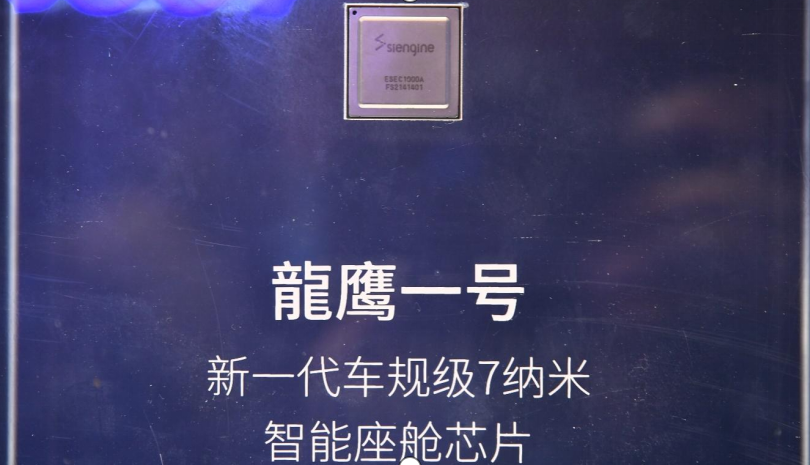
0755-83687076
Author: admin Time:2021-12-15 Click:
Recently, Xingqi Technology publicly released its new generation of 7nm automotive-grade smart cockpit multimedia chip, "Long Ying No. 1." Xingqi Technology was founded by Geely Automobile Holdings' subsidiary Yi Ka Tong Technology and other companies such as Arm China.
Industry experts generally believe that as the automotive electronic and electrical architecture continues to evolve, future cars will gradually develop towards the direction of "mobile travel tools." The smart cockpit will become the core carrier for spatial shaping. Among them, the integration and development of automotive control domains is an inevitable trend in the development of smart cockpits, and smart cockpit chips have become a highland that manufacturers are eager to seize.

"Long Ying No. 1" is a 7nm automotive-grade smart cockpit multimedia chip manufactured by TSMC. It is also one of the few high-end smart cockpit chips on the market that uses 7nm process technology, injecting vitality and confidence into the localization development of high-end chips in China.
According to the progress of automotive intelligence, there are more challenges ahead, whether it's in more advanced process technology or in achieving more intelligent automotive products.
The 7nm smart cockpit chip will enter mass production next year. Journalists learned that "Long Ying No. 1" integrates "one chip for multiple screens and multiple systems" in the smart cockpit, integrating functions such as voice recognition, gesture control, liquid crystal instrument panel, HUD, DMS, and ADAS fusion, which can bring drivers a more personalized interactive experience.
The chip meets the AEC-Q100 Grade 3 level. AEC-Q100 certification is a failure mechanism-based stress test qualification for packaged integrated circuits used in automotive applications, defined by the Automotive Electronics Committee (AEC). It aims to define the qualification requirements and procedures for packaged integrated circuits used in the automotive industry. AEC-Q100 defines four temperature ranges (0, 1, 2, and 3 levels) based on the working temperature range of the integrated circuit system. Unlike consumer electronics, AEC-Q100 certification is more stringent and can be seen as a "ticket" for integrated circuit manufacturers to enter the automotive field.
According to Du Xinze, a senior analyst at CCID Consulting's Artificial Intelligence Industry Research Center, from the perspective of process technology, 7nm belongs to the current leading technology process. For SoC, the internal integrated functions and data transmission and interaction efficiency are also key factors in measuring such products. Compared to the 8-core ARM architecture CPU of NVIDIA's Xavier autonomous driving main control chip, which has a power consumption of 20W and a performance of 20 TOPS, "Long Ying No. 1" has 8 CPU cores, 14 GPU cores, and an 8 TOPS int8 programmable convolutional neural network engine. This smart cockpit chip has reached a unified performance level with the main control chip in many aspects.
"High-end automotive chips are the core driving force for the evolution of automotive intelligence. 'Long Ying No. 1' will drive China's automotive intelligence industry to a new chapter," said Shen Ziyu, Chairman of Xingqi Technology, at the press conference.
Xingqi Technology revealed that "Long Ying No. 1" will enter mass production in the third quarter of 2022 and is expected to be mounted on vehicles by the end of the year. The first model to be equipped is from Geely's brand, and later popular models from Geely will also be equipped with Xingqi Technology's chips.
The integration and development of multiple domains are driving the acceleration of the smart cockpit era.
According to official data, "Long Ying No. 1" is the first high-end smart cockpit chip in China with a 7nm process technology, with 8 CPU cores and 14 GPU cores. In terms of CPU, this chip can provide physical isolation for safety-critical applications, meeting the real-time application requirements of multi-domain integration in vehicles.
With the improvement of automotive intelligence, the automotive electronic and electrical architecture is evolving. The hardware architecture is moving from distributed to domain control and centralized, gradually showing a trend of multi-domain integration.
Domestic companies such as Nuo Bo Technology, Desay SV Automotive, Boytec, and Neusoft are actively promoting multi-domain fusion controllers to the market. In August, Nuo Bo Technology's first product line cockpit domain controller IN9.0 cockpit domain controller went into mass production. It is the first 8155 cockpit domain controller based on Qualcomm's Snapdragon automotive cockpit platform and will be equipped on models from Great Wall Motors and Haval. Desay SV Automotive's independently developed smart cockpit domain controller has been gradually equipped on models such as Chery Tiggo and JETOUR.
Du Xinze believes that in the smart cockpit domain, liquid crystal instrument panels, head-up displays, central control screens, and rear seats require smart cockpit domain controllers for unified multi-screen scheduling and processing. The coordination between functions and experience optimization become challenges for the domain controller. At the same time, with the continuous upgrading of automotive intelligence, the domain controller will need to be granted more rights, and the cooperation between the cockpit domain and other domains